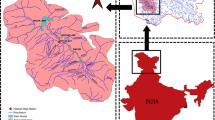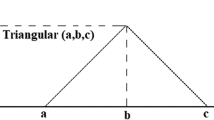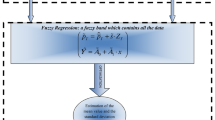Abstract
In this paper, a new non-linear fuzzy-set based methodology is proposed to characterize and propagate uncertainty through a multiple linear regression (MLR) model to predict DO using flow and water temperature as the regressors. The output is depicted as probabilistic rather than deterministic and is used to calculate the risk of low DO concentration. To demonstrate the new method, data from the Bow River in Calgary, Alberta from 2006 to 2008 are used. Low DO concentration has been occasionally observed in the river and correctly predicting, and quantifying the associated uncertainty and variability of DO is of interest to the City of Calgary. Flow, temperature and DO data were used to construct five MLR models, using different combinations of linear and non-linear fuzzy membership functions. The results show that non-linear representation of variance is superior to the linear approach based on model performance. Normal and Gumbel based membership functions produced the best results. The outputs from two non-linear fuzzy membership models were used to calculate risk of low DO. The predicted risk was between 3.9 and 4.9 %. This is an improvement over the traditional method, which can not indicate a risk of low DO for the same time period. This study demonstrates that water resource managers can adequately use MLR models to predict the risk of low DO using abiotic factors.
















Similar content being viewed by others
References
Alberta Environment Protection (1997) Alberta water quality guideline for the protection of freshwater aquatic life: dissolved oxygen. Standards and Guidelines Branch, Alberta Environment, Edmonton
Alberta Environment River Basins (2012) Bow River at Calgary [Online] Available at: http://www.environment.alberta.ca/apps/basins/DisplayData.aspx?Type=Figure&BasinID=8&DataType=1&StationID=RBOWCALG. Accessed 25 Feb 2012
Altunkaynak A, Ozger M, Cakmakci M (2005) Fuzzy logic modeling of the dissolved oxygen fluctuations in Golden Horn. Ecol Model 189:436–446
Alvisi S, Mascellani G, Franchini M, Bárdossy A (2006) Water level forecasting through fuzzy logic and artificial neural network approaches. Hydrol Earth Syst Sci 10(1):1–17
Bárdossy A, Bogardi I, Duckstein L (1990) Fuzzy regression in hydrology. Water Resour Res 26(7):1497–1508
Delhomme JP (1979) Spatial variability and uncertainty in groundwater flow parameters: a geostatistical approach. Water Resour Res 15(2):269–280
Deviney FA Jr, Brown DE, Rice KC (2012) Evaluation of bayesian estimation of a hidden continuous-time Markov chain model with application to threshold violation in water-quality indicators. J Environ Inf 19(2):70–78
Di Baldassarre G, Montanari A (2009) Uncertainty in river discharge observations: a quantitative analysis. Hydrol Earth Syst Sci 13:913–921
Dubois D, Prade H (1991) Random sets and fuzzy interval analysis. Fuzzy Sets Syst 42:87–101
Dubois D, Laurent-Foulloy GM, Prade H (2004) Probability-possibility transformations, triangular fuzzy sets, and probabilistic inequalities. Reliab Comput 10:273–297
Duch W (2005) Uncertainty of data, fuzzy membership functions, and multilayer perceptrons. IEEE Trans Neural Networks 16(1):10–23
El-Baroudy I, Simonovic S (2006) Application of fuzzy performance measures to the City of London water supply system. Can J Civ Eng 33:255–265
Environment Canada Water Office (2012) Bow River at Calgary [Online] Available at: http://www.wateroffice.ec.gc.ca/graph/graph_e.html?stn=05BH004. Accessed 25 Feb 2012
Giusti E, Marsili-Libelli S (2009) Spatio-temporal dissolved oxygen dynamics in the Orbetello lagoon by fuzzy pattern recognition. Ecol Model 220:2415–2426
Guyonnet D, Bourgine B, Dubois D, Fargier H, Come B, Chiles J-P (2003) Hybrid approach for addressing uncertainty in risk assessments. J Environ Eng 129(1):68–78
Hauer FR, Hill WR (2007) Temperature, light and oxygen. In: Hauer FR, Lamberti GA (eds) Methods in stream ecology. Academic Press, San Diego, pp 103–117
He J, Chu A, Ryan MC, Valeo C, Zaitlin B (2011) Abiotic influences on dissolved oxygen in a riverine environment. Ecol Eng 37:1804–1814
Hermann G (2011) Various approaches to measurement uncertainty: a comparison. 2011 IEEE 9th international symposium on intelligent systems and informatics, pp 377–380
Huang Y, Chen X, Li YP, Huang GH, Liu T (2010) A fuzzy-based simulation method for modelling hydrological processes under uncertainty. Hydrol Process 24:3718–3732
Klir GJ (1997) Fuzzy arithmetic with requisite constraints. Fuzzy Sets Syst 91(2):165–175
Kosko B (1997) Fuzzy engineering. Prentice-Hall Inc, Upper Saddle River
Li YP, Huang GH (2012) A recourse-based nonlinear programming model for stream water quality management. Stoch Environ Res Risk Assess 26:207–223
Li YP, Huang GH, Chen X (2009) Multistage scenario-based interval-stochastic programming for planning water resources allocation. Stoch Environ Res Risk Assess 23:781–792
Li YP, Huang GH, Nie SL (2010) Planning water resources management systems using a fuzzy-boundary interval-stochastic programming method. Adv Water Resour 33:1105–1117
McMillan H, Freer J, Pappenberger F, Kruger T, Clark M (2010) Impacts of uncertain river flow data on rainfall-runoff model calibration and discharge predictions. Hydrol Process 24:1270–1284
Mujumdar PP, Sasikumar K (2002) A fuzzy risk approach for seasonal water quality management of a river system. Water Resour Res 38(1):5.1–5.9
Novak V (1989) Fuzzy sets and their applications. Adam Hilger Publishing, Bristol
Pogue TR, Anderson CW (1995) Processes controlling dissolved oxygen and pH in the Upper Willamette River Basin. U.S. Geological Survey, Oregon
Porter DW et al (2000) Data fusion modeling for groundwater systems. J Contam Hydrol 42:303–335
Shiklomanov AI, Yakovleva TI, Lammers RB, Karasev IPh, Vörösmarty CJ, Linder E (2006) Cold region river discharge uncertainty—estimates from large Russian rivers. J Hydrol 326:231–256
Shrestha RR, Nestmann F (2009) Physically based and data-driven models and propagation of input uncertainties in river flood protection. J Hydrol Eng 14(12):1309–1319
Shrestha RR, Simonovic SP (2010) Fuzzy set theory based methodology for the analysis of measurement uncertainties in river discharge and stage. Can J Civ Eng 37:429–439
Shrestha RR, Bárdossy A, Nestmann F (2007) Analysis and propagation of uncertainties due to stage-discharge relationship: a fuzzy set approach. Hydrol Sci J 52(4):595–610
Wang S, Huang G, Lu HW, Li YP (2011) An interval-valued fuzzy linear programming with infinite α-cuts method for environmental management. Stoch Environ Res Risk Assess 25:211–222
Wang S, Huang GH, Yang BT (2012) An interval-values fuzzy-stochastic programming approach and its application to municipal solid waste management. Environ Model Softw 29:24–36
Watt WE (ed) (1989) Hydrology of floods in Canada: a guide to planning and design. Associate Committee on Hydrology, National Research Council, Ottawa
Xia X, Wang Z, Gao Y (2000) Estimation of non-statistical uncertainty using fuzzy-set theory. Meas Sci Technol 11(4):430–435
YSI Environmental (2012) YSI 5200A continuous multiparameter RAS monitor [Online]. Available at: http://www.ysi.com/media/pdfs/W45-5200A-Continuous-Multiparameter-Monitor.pdf. Accessed 25 Feb 2012
Zadeh LA (1965) Fuzzy sets. Inf Control 8:338–353
Zadeh LA (1978) Fuzzy sets as a base for a theory of possibility. Fuzzy Sets Syst 1:3–28
Zadeh LA (1987) Probability measures of fuzzy events. In: Yager RR, Ovchinnikov S, Tong RM, Nguyen HT (eds) Fuzzy sets and applications: selected papers by L. A. Zadeh. Wiley, New York, pp 45–52
Zhang K (2009) Modeling uncertainty and variability in health risk assessment of contaminated sites. Ph.D. Thesis, University of Calgary, Canada, pp 72–74
Zhang K, Achari G (2010a) Correlations between uncertainty theories and their applications in uncertainty propagation. In Furuta H, Frangopol DM, Shinozuka M (eds) Safety, reliability and risk of structures, infrastructures and engineering systems. Taylor & Francis Group, London, UK, pp 1337–1344
Zhang K, Achari G (2010b) Uncertainty propagation in environmental decision making using random sets. ISEIS 2010 annual conference, pp 576–584
Zhang K, Li H, Achari G (2009) Fuzzy-stochastic characterization of site uncertainty and variability in groundwater flow and contaminant transport through a heterogeneous aquifer. J Contam Hydrol 106:73–82
Acknowledgments
The authors would like to thank the Natural Sciences and Engineering Research Council of Canada for funding this project, Dr. Cathryn Ryan (Department of Geoscience, University of Calgary) and Dr. Angus Chu (Department of Civil Engineering, University of Calgary) for providing the data sets used in this work. The authors are also grateful for the helpful feedback and comments from two anonymous reviewers.
Author information
Authors and Affiliations
Corresponding author
Rights and permissions
About this article
Cite this article
Khan, U.T., Valeo, C. & He, J. Non-linear fuzzy-set based uncertainty propagation for improved DO prediction using multiple-linear regression. Stoch Environ Res Risk Assess 27, 599–616 (2013). https://doi.org/10.1007/s00477-012-0626-5
Published:
Issue Date:
DOI: https://doi.org/10.1007/s00477-012-0626-5




